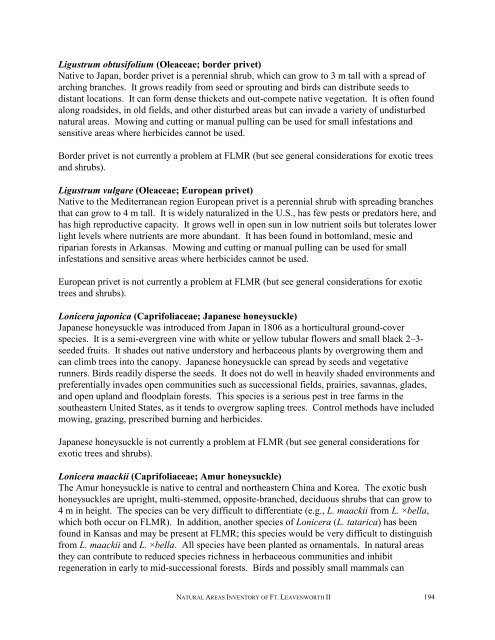A Natural Areas Inventory of the - Kansas Natural Heritage Inventory ...
A Natural Areas Inventory of the - Kansas Natural Heritage Inventory ...
A Natural Areas Inventory of the - Kansas Natural Heritage Inventory ...
Create successful ePaper yourself
Turn your PDF publications into a flip-book with our unique Google optimized e-Paper software.
Ligustrum obtusifolium (Oleaceae; border privet)<br />
Native to Japan, border privet is a perennial shrub, which can grow to 3 m tall with a spread <strong>of</strong><br />
arching branches. It grows readily from seed or sprouting and birds can distribute seeds to<br />
distant locations. It can form dense thickets and out-compete native vegetation. It is <strong>of</strong>ten found<br />
along roadsides, in old fields, and o<strong>the</strong>r disturbed areas but can invade a variety <strong>of</strong> undisturbed<br />
natural areas. Mowing and cutting or manual pulling can be used for small infestations and<br />
sensitive areas where herbicides cannot be used.<br />
Border privet is not currently a problem at FLMR (but see general considerations for exotic trees<br />
and shrubs).<br />
Ligustrum vulgare (Oleaceae; European privet)<br />
Native to <strong>the</strong> Mediterranean region European privet is a perennial shrub with spreading branches<br />
that can grow to 4 m tall. It is widely naturalized in <strong>the</strong> U.S., has few pests or predators here, and<br />
has high reproductive capacity. It grows well in open sun in low nutrient soils but tolerates lower<br />
light levels where nutrients are more abundant. It has been found in bottomland, mesic and<br />
riparian forests in Arkansas. Mowing and cutting or manual pulling can be used for small<br />
infestations and sensitive areas where herbicides cannot be used.<br />
European privet is not currently a problem at FLMR (but see general considerations for exotic<br />
trees and shrubs).<br />
Lonicera japonica (Caprifoliaceae; Japanese honeysuckle)<br />
Japanese honeysuckle was introduced from Japan in 1806 as a horticultural ground-cover<br />
species. It is a semi-evergreen vine with white or yellow tubular flowers and small black 2–3seeded<br />
fruits. It shades out native understory and herbaceous plants by overgrowing <strong>the</strong>m and<br />
can climb trees into <strong>the</strong> canopy. Japanese honeysuckle can spread by seeds and vegetative<br />
runners. Birds readily disperse <strong>the</strong> seeds. It does not do well in heavily shaded environments and<br />
preferentially invades open communities such as successional fields, prairies, savannas, glades,<br />
and open upland and floodplain forests. This species is a serious pest in tree farms in <strong>the</strong><br />
sou<strong>the</strong>astern United States, as it tends to overgrow sapling trees. Control methods have included<br />
mowing, grazing, prescribed burning and herbicides.<br />
Japanese honeysuckle is not currently a problem at FLMR (but see general considerations for<br />
exotic trees and shrubs).<br />
Lonicera maackii (Caprifoliaceae; Amur honeysuckle)<br />
The Amur honeysuckle is native to central and nor<strong>the</strong>astern China and Korea. The exotic bush<br />
honeysuckles are upright, multi-stemmed, opposite-branched, deciduous shrubs that can grow to<br />
4 m in height. The species can be very difficult to differentiate (e.g., L. maackii from L. ×bella,<br />
which both occur on FLMR). In addition, ano<strong>the</strong>r species <strong>of</strong> Lonicera (L. tatarica) has been<br />
found in <strong>Kansas</strong> and may be present at FLMR; this species would be very difficult to distinguish<br />
from L. maackii and L. ×bella. All species have been planted as ornamentals. In natural areas<br />
<strong>the</strong>y can contribute to reduced species richness in herbaceous communities and inhibit<br />
regeneration in early to mid-successional forests. Birds and possibly small mammals can<br />
NATURAL AREAS INVENTORY OF FT. LEAVENWORTH II 194


